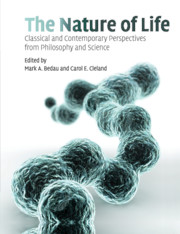Book contents
- Frontmatter
- Contents
- Preface
- Acknowledgments
- Sources
- About the authors
- Introduction
- SECTION I CLASSICAL DISCUSSIONS OF LIFE
- 1 De Anima (selections)
- 2 Treatise on Man
- 3 Critique of the teleological power of judgment (selections)
- 4 What is Life? (selections)
- 5 The nature of life
- 6 What is the meaning of “life”?
- 7 The principles of life (selections)
- SECTION II THE ORIGIN AND EXTENT OF NATURAL LIFE
- SECTION III ARTIFICIAL LIFE AND SYNTHETIC BIOLOGY
- SECTION IV DEFINING AND EXPLAINING LIFE
- Supplementary bibliography on life
- Index
- References
6 - What is the meaning of “life”?
Published online by Cambridge University Press: 10 November 2010
- Frontmatter
- Contents
- Preface
- Acknowledgments
- Sources
- About the authors
- Introduction
- SECTION I CLASSICAL DISCUSSIONS OF LIFE
- 1 De Anima (selections)
- 2 Treatise on Man
- 3 Critique of the teleological power of judgment (selections)
- 4 What is Life? (selections)
- 5 The nature of life
- 6 What is the meaning of “life”?
- 7 The principles of life (selections)
- SECTION II THE ORIGIN AND EXTENT OF NATURAL LIFE
- SECTION III ARTIFICIAL LIFE AND SYNTHETIC BIOLOGY
- SECTION IV DEFINING AND EXPLAINING LIFE
- Supplementary bibliography on life
- Index
- References
Summary
Primitive humans lived close to nature. Every day they were occupied with animals and plants, as gatherers, hunters, or herdsmen. And death—of infants and elders, women in childbirth, men in strife—was forever present. Surely our earliest ancestors must have wrestled with the eternal question, “What is life?”
Perhaps, at first, no clear distinction was made between life in a living organism and a spirit in a nonliving natural object. Most primitive people believed that a spirit might reside in a mountain or a spring as well as in a tree, an animal, or a person. This animistic view of nature eventually waned, but the belief that “something” in a living creature distinguished it from inanimate matter and departed from the body at the moment of death held strong. In ancient Greece this something in humans was referred to as “breath.” Later, particularly in the Christian religion, it was called the soul.
By the time of Descartes and the Scientific Revolution, animals (along with mountains, rivers, and trees) had lost their claim to a soul. But a dualistic split between body and soul in human beings continued to be almost universally accepted and is even today still believed by many people. Death was a particularly puzzling problem for a dualist. Why should this soul suddenly either die or leave the body? If the soul left the body, did it go somewhere, such as to some nirvana or heaven?
- Type
- Chapter
- Information
- The Nature of LifeClassical and Contemporary Perspectives from Philosophy and Science, pp. 88 - 101Publisher: Cambridge University PressPrint publication year: 2010
References
- 1
- Cited by



